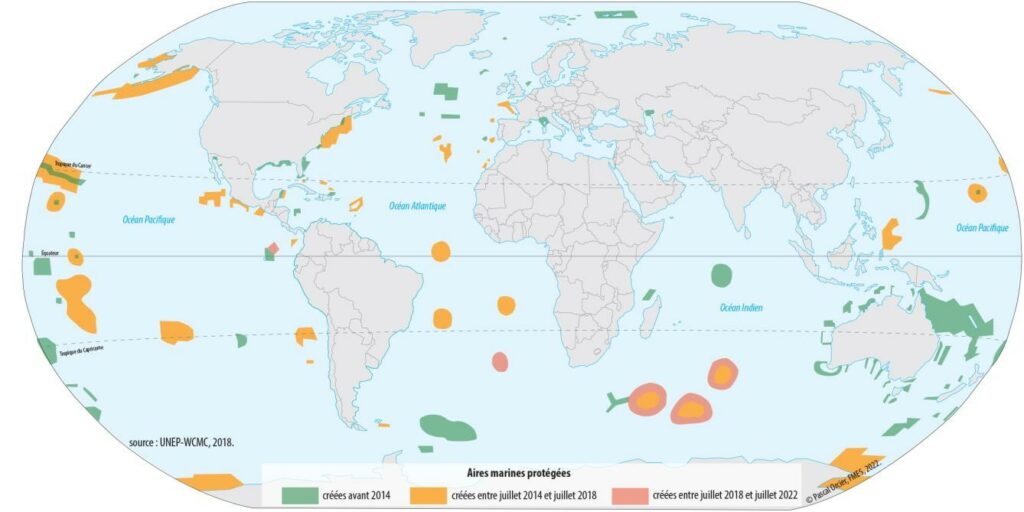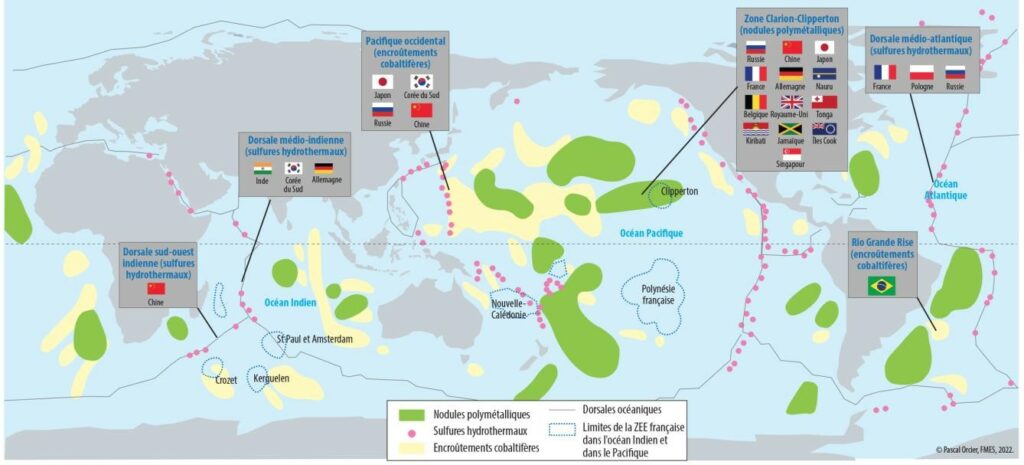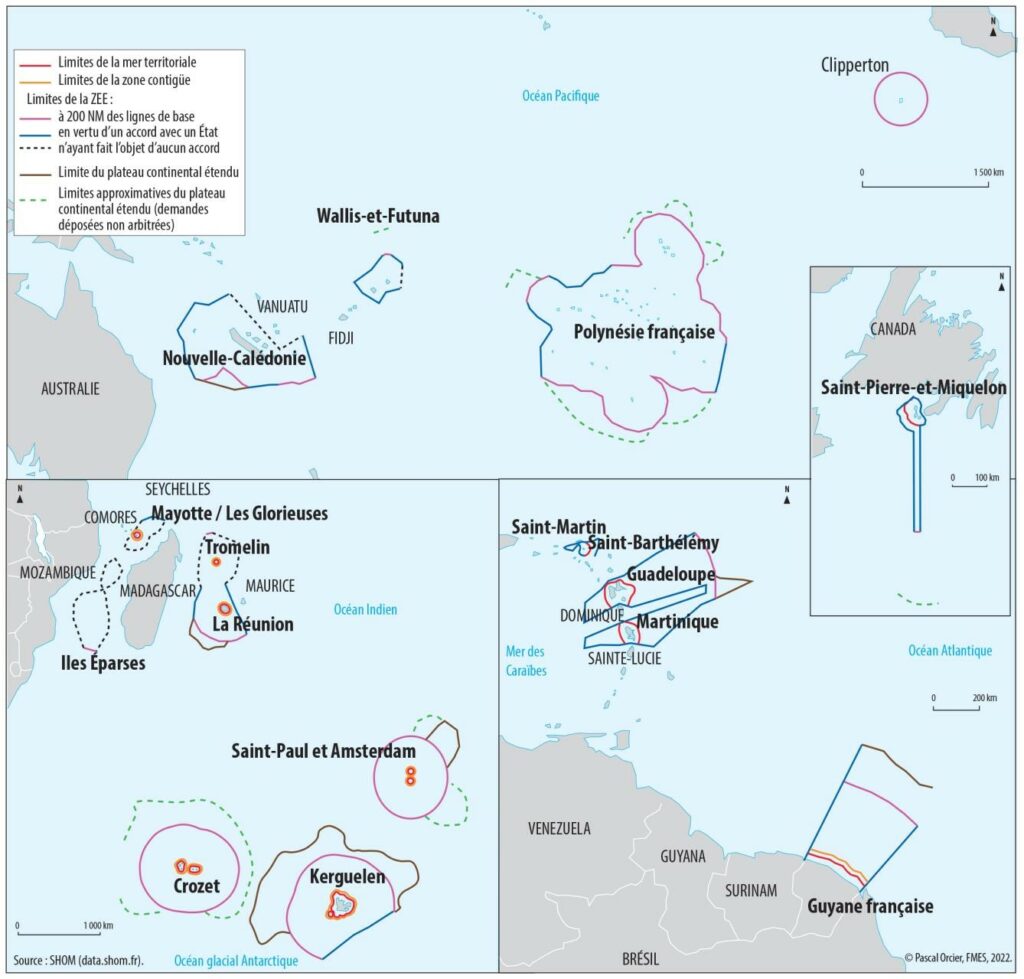France is often referred to as a maritime power because it has jurisdiction over the world’s second largest EEZ with 10.2 million km2. Above all, this presentation shows a poor understanding of the maritime dimension. For what makes power at sea is not the possession of “vast acres of sea,” but the ability of a state to move, trade, exploit, protect, and fight in it. This requires fleets, technologies, ports and…seafarers.
Among France’s maritime assets is, of course, the existence of territories all around the globe that provide it with a global presence that no other nation in the world has. Thanks to these French lands, our country has real potential in terms of influence, permanence, development and power. But the quid pro quo must be our ability to protect and defend these territories that will be increasingly coveted.
The disruption to the strategic landscape in the Indo-Pacific region facing France’s overseas territories.
The new geopolitical context presents both opportunities and challenges for the Overseas Territories.
The good news is that our world is “getting married” more and more. In this context, the ultramarine territories have interesting opportunities for development and trade. They are becoming more strategic every day.
The bad news is that new powers, most notably China, are developing conquest strategies that extend to the sea. Our overseas territories are on the front line. Isolation is no longer a safeguard. The defense of these territories is becoming an ardent necessity.
90% of France’s territory lies in the Indo-Pacific region, where the world’s center of gravity has shifted. Here is where China is patiently weaving its webs, and taking one position at a time that could secure its supremacy in the future. Its dream of great power “depends on the maritime economy that forms the backbone of its economy.” [1]So, in keeping with its Go culture, it expands its maritime power by acting on each of the factors with determination. China now accounts for 59% of the world’s shipbuilding, has 15 of the world’s top 20 ports, the world’s largest merchant fleet (250 million tons of gross tonnage), and the world’s second largest military fleet.
On the oceans, China has adopted a constrictor strategy, piling on small actions that will not provoke casus belli, but will lead to major strategic change. It has developed a military and commercial presence in ports such as Djibouti, Gwadar in Pakistan, and Kyaukpyu in Burma, close to major international straits. Currently, it is deploying towards the Pacific Islands where it is continuing its implementation work. This is also the case in the Solomon Islands where, in 2024, it has just signed major security agreements that could lead to the establishment of a military base soon.
The other major emerging maritime power is India. Fearing China’s maritime activism in the Indian Ocean, India is also pursuing a policy of expanding its fleet and establishing naval bases. But, unlike China, this policy is conducted in cooperation with Western powers. For example, the US has provided ports of call to India at its large naval base in Diego Garcia and to France in Réunion. After establishing naval bases on its Andaman and Nicobar islands at the outlet of the Strait of Malacca, India on March 6, 2024, inaugurated a second naval military base in the Laquedives archipelago of Minicoy on a sensitive sea route.
France’s New Overseas Geopolitical Challenges
As a result, France’s ultramarine territories in the Indo-Pacific (90% of DROM-COMs) are now on a global fault line. In a few years, they have become geostrategic interfaces in coveted Oceans, allowing France to be as close as possible to areas of tension.
For France’s Pacific territories, the stakes are now linked to China’s own agenda, which has adopted a very proactive policy of influence. With a multidimensional approach covering various sectors such as security, the economy, culture, international relations and the environment, this strategy of influence aims to bring island states into its sphere of influence.
China also knows how to take advantage of states that are in crisis or destabilized, as the Solomon Islands or Vanuatu show us. It is undeniable that the current crisis in New Caledonia is a powerful destabilizing factor for France in this area of the Pacific playing in China’s favor.
And the French Indian Ocean territories are regaining the strategic position they lost with the inauguration of the Suez Canal in the late nineteenth century. Indeed, Houthi rebels’ actions in the Red Sea against commercial vessels have had an effect by halving the number of vessels in the Suez Canal in the first half of 2024.
Faced with threats in the Red Sea’s coastal waters, merchant fleets are increasingly diverting to the high seas. This is what has already started, as 7.6 million tons of goods now pass through the Cape of Good Hope, compared to 1.8 million tons in the Suez Canal. In these circumstances, islands such as Mayotte or Reunion are of major strategic importance and could become even more important in the future if the passage through Suez were to constitute an unacceptable risk for maritime carriers.
These territories are also important for preventing another danger to maritime traffic, piracy. This threat, if currently contained in the Indian Ocean, is not expected to disappear and will remain permanent. It may even gain momentum with the advent of new technologies that will make it easier to attack commercial ships. Considering the known range of action of Somali pirates, the naval bases of Reunion and Mayotte will remain very important to contribute to the security of maritime transport.
The maritime challenges of the French Overseas Territories.
With the exception of French Guiana, all French overseas territories are islands whose paradox is that, although they depend very heavily on the sea, they have difficulty in transforming this constraint into an asset. Yet real potential exists that could be based on a dynamic and resilient blue economy and their strategic dimension.
The challenge of maritime transport
Given their high dependence on imports, the first of the maritime challenges of overseas territories is the maintenance of maritime supply routes.
This is the case first of all for food supplies, which range from 67% for French Guiana to 87% for Martinique, and even 98% for Saint-Pierre and Miquelon. High population density, scarcity of agricultural land and increasing urbanization will aggravate this situation in the future, with the exception, however, of Guyana.
The other vital overseas dependency concerns energy. With the exception of Reunion, which produces 10% of renewable energy, all DROM-COMs are totally dependent on fuel oil, gas or coal for their electrical production and the needs of industry and the population.
In the current context of widespread questioning of the world order and naval rearmament, the very high dependence of these territories on external supplies is a real fragility. The threats that could lead to an interruption of logistical flows are not on paper. For this reason, we must take very seriously the prevention of this type of crisis, which requires three major measures.
Firstly, to have strategic food reserves in the DROM-COMs which could either rely on the private sector or on crisis stocks in ports[2]. Moreover, France needs to be able to rely on a strategic commercial fleet. It already exists, but, as recommended by MP Yannick Chenevard in his recent report on the Strategic Fleet[3], it needs to be accompanied by more proactive and more…strategic measures. Finally, maintaining logistical links requires the ability of French and allied navies to protect traffic destined for overseas territories.
The challenge of exploiting fisheries resources.
Among the sectors of the blue economy, fisheries and aquaculture appear to be obvious resources in the French overseas territories. Their vast EEZs contain large and well-managed stocks of high value-added species such as tuna, toothfish, shrimp and lobster. However, the sector is often in a loss-making position, despite the considerable resources deployed by the State to finance the sector and preserve its resources.
Overseas fishing is in a mixed situation. Artisanal and inshore fishing is aging and failing to meet the needs of the population. The paradox is that these areas, which are endowed with fish resources, must import considerable quantities of fish.
Offshore fishing has improved and thrived in recent years. It is a sector with undeniable growth potential. For example, fishing for toothfish in the waters of the French Southern and Antarctic Territories (TAAF) by longliners from Reunion alone generates 8% of the total French value added with only 1% of the quantities fished. It is a fishery that is very well organized and well controlled by the TAAF administration.
In Polynesia, deep-sea fishing is also in the midst of a revival. It has increased by 30% in five years to 80 units, representing an additional 42% tonnage. Polynesia wants to triple its fleet in the next few years, with significant fish stocks in its waters.
In all cases, these fishing fleets can rely on well-controlled maritime areas, in particular by the means of the Navy as part of the action of the State at sea. The major police operations in the early 2000s in the TAAF, the permanent patrols in the Pacific EEZs, have made it possible to improve the situation and to push illegal fishing fleets out of the limits of the EEZs. There remains a sensitive area, Guyana, where incursions by fishermen from neighboring Brazil or Suriname are permanent and often require the use of armed force to intercept offending vessels.
The End of the Mirage of the Deep Seabed?
In its offshore EEZs, France could also have significant mineral resources that are still far from being fully investigated. Since the early 1970s, France, under the auspices of IFREMER, has maintained cutting-edge research in the field of deep-sea exploration and exploitation and in their access technologies. Still with this prospect of exploitation, France has systematically requested extensions of its continental shelf, increasing it to make it the first in the world with 11 million km2. But doubts about the environmental consequences of exploitation began to arise in the context of climate change. In November 2022, the President of the Republic set a new position for France, that of a moratorium on exploitation, pending environmental assessments.
At present, during the negotiations on the future mining code within the framework of the International Seabed Authority, twenty-seven states have joined France’s proposal for a moratorium.
This position constitutes a complete reversal of the French position. It will make sense if the international community follows our lead, but it is far from certain. For, at the same time, states like Norway, China, and Nauru are driving the fires to begin exploitation.
Combating illicit activities at sea.
The twenty-first century has been marked by profound geopolitical upheavals, but above all by an unprecedented level of crime. With the commodification of technologies and the globalization of trade, mafia networks are able to take advantage of this situation to transport their illicit cargoes from one continent to another.
The Caribbean has become an important base for combating trafficking at sea with the establishment of an OFAST antenna on site and, at sea, interception assets belonging to the Navy and Customs. For naval units operating out of the West Indies, the fight against drug trafficking has become the primary mission, and all state sensors are geared toward intercepting potential drug traffickers. This combat is also regional because the coordination of combat operations can also be carried out by the US-led Joint Interagency Task Force South (JIATF-S) based in Florida, which brings together some twenty countries in the area.
This struggle also involves Reunion, but to a lesser degree. Indeed, one of the sea routes for heroin smuggling from Iran runs through the northern Indian Ocean to East African countries and then onward to other destinations, including Europe.
Thanks to this pre-positioning of assets in the French overseas territories, the French Navy is the one in Europe that carries out the largest seizures. In 2021, it intercepted 44.8 tons of drugs across all oceans, worth €2 billion (33 tons in 2023). This result makes France one of the leading global players in the fight against this scourge at sea.
The new challenge of protecting the environment at sea
Protecting the environment at sea has become a sensitive issue for an ocean nation like France. This includes the creation of marine protected areas (MPAs), the concept of which was born in 1992. Many states, because of their international commitments, have established marine protected areas. 28 million km2 are now under this status, or 7.7% of maritime areas.
France has an offensive policy in this area. In its National Strategy for Protected Areas, it has already endorsed the Convention on Biological Biodiversity’s 30X30[4] target by declaring 34.9% of its marine areas protected areas. With 3.5 million km2 of marine areas in MPAs, France is the world leader, ahead of the USA (3.3 million km2).
97% of these MPAs are in French ultra-marine waters, which contain 80% of France’s biodiversity. This is where France has created the second largest area in the world, the French Southern Lands, with an area of 1.6 million km2. The other major MPAs are those of Polynesia, the Coral Sea Nature Park in New Caledonia (1.3 million km²) and marine nature parks covering all the EEZs of Mayotte, Glorieux and Martinique.
Of course, many NGOs are outraged that the level of protection in these areas is not high enough and that we are dealing with ‘paper’ marine areas. This accusation can sometimes be made for highly coastal marine protected areas where surveillance and interception are more complex. However, this is much less true for our large marine areas, given their remoteness, which does not favor the discretion of potential vessels in violation of the detection and intervention means put in place.
Conclusion
The future of France’s overseas territories will be closely tied to maritime activities, given their economic and environmental reliance on the ocean.
But France, like China, must also develop a “Manaanite” vision of the sea, drawing on its powerful navy and overseas territories. These territories will have to be protected but also valued as strategic points of support. As Pierre Nerville wrote in his book on the late nineteenth-century American naval strategist Admiral Mahan: “For Mahan, the elements of sea control are trade in rising production, necessary trade, control of sea lanes, and possession of nearby or distant port bases in case of tension and war.”[5]
Since the early 1990’s, in order to capture the “peace dividend,” the military posture in these territories has weakened considerably. The Military Programming Law 2024 / 2030 states that the armed forces will be strengthened overseas. For the Navy, this will mean the delivery of six new maritime patrol vessels and the first corvette to replace the surveillance frigates. With more autonomy, these units will be better able to monitor and respond to EEZs. These new projection capabilities will be complemented by next-generation maritime surveillance and response aircraft and drones.
But, as can be seen, this effort is really just catching up with a renewal of resources that has been constantly postponed. It is not up to the challenges of the new international environment. There is still time to mitigate emerging threats. In the new world, two territories should be subject to a special effort to avoid any possibility of escalation. These are New Caledonia and Mayotte/Reunion, where France’s destabilization operations have begun. It is in these areas that we should concentrate our forces. But to do so, there is no mystery: we must now consent to this “war effort,” which should not be a mere slogan, by returning to the financial volumes we had prior to the fall of the Berlin Wall. The reality of our “war effort” has an indicator that doesn’t lie. It’s the percentage of GDP that we spend on defense. At 2%, France is still far from meeting the growing threats. Otherwise, we will be doomed to endure the new world order that is coming… and of which the French overseas territories are on the front line.

Map of marine protected area extensions – FMES 2022

Map of deep mineral resources – FMES 2022

French Overseas Maritime Delimitation Map – FMES 2022
[1] Hugues Eudeline, “Objectifs politiques de la Chine et stratégie maritime (2/2) (T 1262)”, RDN, Apris 2, 2021
[2] 2022 Annual Report of the Court of Auditors, Part 6, “La sécurité des approvisionnements alimentaires”.
[3] Report from the government mission on the reassessment of the strategic fleet arrangement by MP Yannick Chenboulevard, July 17, 2023.
[4] Target 30X30 is defined by Target 3 of the Convention on Biological Diversity (CBD) Global Biodiversity Framework (GBF). By 2030, states will be required to place 30% of land, inland waters and oceans in protected areas and other effective area-based conservation measures.
[5] Mahan and the Master of the Seas, Pierre Nerville, Strategies, Bibliothèque Berger-Levrault, 1981.